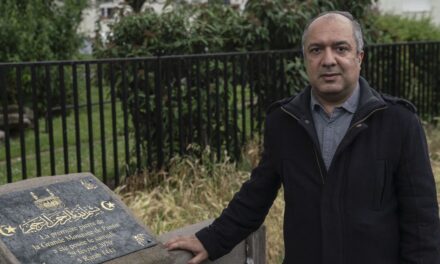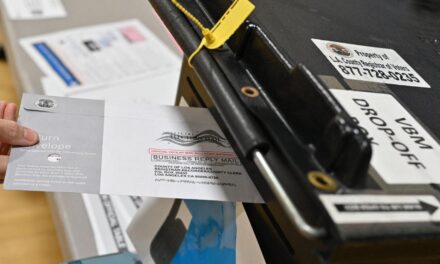
Spike Lee flub leaves Cannes audience gasping

French filmmaker Julia Ducournau has become only the second female director to win the Palme d’Or, the Cannes Film Festival’s top prize, for her film “Titane.”
In a shock moment, jury president Spike Lee announced the win in error early in the awards ceremony after a miscommunication. Gasps rang around the Grand Theatre Lumiere before the ceremony collected itself and reverted back to the normal running order. The awkward atmosphere did not dissipate, however, with the typically garrulous Lee noticeably bashful.
“Raw” director Ducournau returned to Cannes with her second film, her first in competition. “Titane” tells the story of a young woman who survives a car crash as a child and goes on to have a peculiar relationship with cars in adulthood. It divided critics with vocal supporters and detractors, but the jury of Lee, fellow directors Mati Diop, Kleber Mendonça Filho, Jessica Hausner, actors Maggie Gyllenhaal, Mélanie Laurent, Tahar Rahim and Song Kang-ho and singer-songwriter Mylène Farmer saw fit to award it top honors.

Spike Lee, Jury members Tahar Rahim, Maggie Gyllenhaal, Jessica Hausner and Mélanie Laurent on stage during the closing ceremony.
Credit: Andreas Rentz/Getty Images Europe/Getty Images
The Grand Prix — the festival’s second prize — was jointly awarded to Asghar Farhadi’s “A Hero” and Juho Kusomanen’s “Compartment No.6.”
A two-time Oscar winner from Iran, Farhadi’s intricate morality play “A Hero” centers on a prisoner whose good deed on day release sets off a chain of fortune and misfortune.
“Compartment No.6” has been compared to a “Finnish ‘Before Sunrise'” for its offbeat meet-cute set on a train.
“Memoria” by Thai director Apichatpong Weerasethakul and “Ahed’s Knee” by Israeli Nadav Lapid shared the Jury Prize.
Best director went to Frenchman Leos Carax for his musical “Annette,” starring Adam Driver and Marion Cotillard as A-list lovers in a doomed romance, set to music by cult pop duo Sparks. Best screenplay was awarded to Ryusuke Hamaguchi for “Drive My Car,” the Japanese director’s adaptation of a Haruki Murakami short story.
Best actor went to Caleb Landry Jones for “Nitram,” Justin Kurzel’s retelling of the 1996 Port Arthur massacre in Australia, while best actress went to Renate Reinsve for Joachim Trier’s “The Worst Person in the World.”
Camera d’Or for first film (and award spanning the Official Selection and the wider program’s The Director’s Fortnight and Critics’ Week) went to Antoneta Alamat Kusijanovic for “Murina,” her tense family drama set on the Adriatic Coast.
The reports of cinema’s death have been greatly exaggerated.

“Memoria” by Apichatpong Weerasethakul.
Credit: Kick the Machine Films/Burning/Anna Sanders Films/Match Factory Productions/ZDF-Arte/Piano
After Cannes was canceled in 2020, the festival set out to be the savior of cinema by returning big movies to the big screen. Many festivals have, in the past 12 months, gone hybrid or virtual (Venice being the notable exception), but this would not do for the Côte d’Azur. There is no glamor to be found at online screenings, and what is Cannes without glamor? Diamonds and couture do not photograph well on Zoom.
No one would ever accuse the festival of thinking too little of itself, but when a program stacked with huge names was unveiled in June, Cannes’ savior complex started looking justified.
A rumbling pandemic had other ideas. Covid-19 restrictions have made life difficult for traveling industry figures and press, many of whom were required to take tests every 48 hours in order to access the Palais des Festivals. (Twitter has been awash with nearly as many reviews of saliva samples as of films in recent weeks.) Some, alas, did not make it — including this writer. But perhaps more importantly for festival organizers, Lea Seydoux, who would have been everywhere with no fewer than four films in the Official Selection, was kept at home by a positive coronavirus test (she is reportedly asymptomatic).
Tilda Swinton filled the void, her ethereal presence gracing films by Joanna Hogg, Wes Anderson, Apichatpong Weerasethakul and Mark Cousins — as varied a group a directors as one could hope to assemble.
1/55
Julia Roberts’ daughter, Hazel Moder, made her first-ever red carpet debut alongside father Daniel Moder. Credit: Daniele Venturelli/WireImage/Getty Images
Many festival luminaries returned to the Croisette, providing talking points but leaving empty handed. Among them were Jacques Audiard, Bruno Dumont, François Ozon and Nanni Moretti.
Another old hand was Paul Verhoeven, an agent provocateur who’s been walking the tight rope of high trash/high art (depending on how you read his films) for years now. “Benedetta,” his historical nunsploitation movie starring Virginie Efira, wasn’t lacking in controversy.
Indeed, both “Annette” and “Benedetta” contributed to what was a horny old festival on many accounts. Other trends this year included seemingly every other film being compared to the Safdie brothers’ “Uncut Gems,” and the meme-ification of “The French Dispatch’s” photo call (who knew Timothée Chalamet, Wes Anderson, Tilda Swinton and Bill Murray were so relatable?).

“Benedetta” by Paul Verhoeven.
Credit: Guy Ferrandis/SBS Productions
Once the froth of the festival settles, what’s left is another crop of films from around the world, from places expected and not, rated, reviewed and ready to find their way to the public. So Cannes’ mission can be said to be a success.
Cannes has always been a case of “in with the new,” making a pause to reflect on what’s come before all the more necessary. Mark Cousins provided that with his documentary “The Story of Film: A New Generation,” which preceded the opening ceremony and cast an eye over the past decade of cinema. In it, he posed the question: Which films have pushed the boundaries of the medium? Moreover, how?
It’s a useful frame through which to view cinema, beset as it is with doomsayers bemoaning the streaming wars and the recycling of intellectual property. New things are happening all around us — as long as you’re looking in the right places. It’s also a useful frame through which to view Cannes, where there is always more to discuss than time allows.
Here’s a selection of films, from both the 2021 festival’s Official Selection and wider program, that pushed boundaries and injected new life into cinema.
“Petrov’s Flu” (dir. Kirill Serebrennikov)

“Petrov’s Flu” by Kirill Serebrennikov.
Credit: Hype Film
Kirill Serebrennikov takes us on a 24-hour tour of Yekaterinburg on New Year’s Eve that’s less “Ulysses”-of-the-Urals and more like jumping into a Hieronymus Bosch painting of post-Soviet Russia.
Our unwitting guide is Petrov (Semyon Serzin), a comic book artist whose bout of flu sends viewers into a tailspin. He’s feverish, the city’s febrile, and events — real and imagined — collide. From a crowded bus to a public execution and then into the back of a stolen hearse, we ride with the protagonist along the underbelly of society, meeting an ensemble of characters painted in shades absurd, grotesque and pathetic.
Petrov’s librarian wife Petrova (Chulpan Khamatova) isn’t faring much better, with a murderous streak that could be fact or fiction. Frankly, it’s hard to tell. Meanwhile, their son’s temperature is creeping up.
Based on Alexey Salnikov’s novel “The Petrovs In and Around the Flu,” Serebrennikov’s adaptation is Dostoevsky read through a kaleidoscope. Characters, scenes and sets collapse in on one another — sometimes literally — and occasionally in outrageous long takes that baffle as much as they beguile. It’s cinema as surreal, relentless spectacle, recalling Leos Carax’s “Holy Motors” and Aleksei German’s “Hard to be a God,” but wholly Serebrennikov’s own groove: furiously inventive, brutish at times, unexpectedly tender at others.
The Russian director, barred from leaving the country to attend the festival, installs a nostalgic backstory that dovetails with the rest of the narrative only in the closing stages. Characters retreat into fantasy, but also the past. It suggests a yearning — if not for the past, then maybe for simpler times or ones when the rot was less pervasive. The film’s manifesto may be unclear, but its diagnosis is more so: a city and its people are sick.
“Neptune Frost” (dir. Saul Williams and Anisia Uzeyman)

“Neptune Frost” by Saul Williams and Anisia Uzeyman.
Credit: Swan Films
With the backing of Lin-Manual Miranda and Ezra Miller comes a Rwandan Afrofuturist musical that’s also an exploration of intersex identity. There’s a lot going on in Saul Williams and Anisia Uzeyman’s film about a collective of cyberpunk revolutionaries; kudos to the directors that so much of it works.
Circumstances bring together exploited miner Matalusa (Kaya Free) and intersex Neptune (played by both Elvis Ngabo and Cheryl Isheja), whose union draws other revolutionaries to their cause. As one of Matalusa’s fellow rare-mineral miners notes, “We power systems more effectively than we destroy them.” Time for that to change. Costumed in discarded tech (Matalusa’s QWERTY key jacket is a highlight), these keyboard warriors are out to transform the real world and take down the unnamed “Authority.”
Just like the characters who sing “Neither/neither, Won’t be either/either,” the script talks in metaphor and riddle, frequently speaking to more than one aspect of the story simultaneously. Meaning stacks up, but can also become obscured. But if the film’s narrative is hard to follow at times, what’s unmistakable is how good the music is — rhythmic, communal and unpretentious. “Neptune Frost” is a musical that wears its musicality lightly.
Staunchly intersectional, wildly ambitious, it’s a film that plants a seed of countercultural hope while pushing back the boundaries of the genre.
“Hit the Road” (dir. Panah Panahi)

“Hit the Road” by Panah Panahi.
Credit: JP Production
From the synopsis, Panah Panahi’s debut reads like an Iranian “Little Miss Sunshine”: A sweet but dysfunctional family road trip, complete with charismatic youngster, surly older brother and troublesome cargo in the trunk. And it’s all that — but also much more.
We meet the family on the road. Mom (Pantea Panahiha) is up front while Dad (Hassan Madjooni) rides in the back with his leg in a cast, struggling to control chatty youngster (a breakout Rayan Sarlak). Big brother (Amin Simiar) is at the wheel and notably quiet. More notable still, we don’t know why they’re on the road, or why SIM cards are being destroyed amid fears the family is being tailed.
Some viewers will realize the truth quicker than others, but frankly it doesn’t matter. For the most part, we’re too occupied with the journey to think about the destination.
Panahi (son of Cannes favorite, Jafar) has crafted a wonderful four-wheeled chamber piece around four terrific performances. Sarlak’s youthful energy prods at the older actors, while Panahiha, seamlessly moving up and down the gears, has the hardest task of all as the film’s emotional linchpin (it was the strongest performance at the festival I saw). For many of us, separated from loved ones in the past 18 months, there’s poignant pleasure in watching a family bicker. We understand that, despite the exasperation, every word is underwritten with love. And when the conversation turns serious, it lands all the harder.
This is a film that radiates warmth, protecting Panahi’s characters — and the audience — against a devastating note at its heart. You’ll miss your time hitching a ride alongside them.
“Great Freedom” (dir. Sebastian Meise)

“Great Freedom” by Sebastian Meise.
Credit: Freibeuterfilm_Rohfilm
Franz Rogowski is an actor at the top of his game, and he’s never had a better vehicle than Sebastian Meise’s time-hopping prison drama.
Hans (Rogowski) is a gay man in mid-century West Germany serving multiple sentences under Paragraph 175, a historic law criminalizing sexual acts between men. It’s the same law that put him in a concentration camp in World War II and, remarkably, saw him transferred to prison once the camp was liberated.
We travel through time, via Hans’ trips to an isolation cell (lights off, lights on), reemerging with teddy boy coiffure or a porn-star-style moustache to help viewers distinguish between 1945, 1957 and 1968. The men in Hans’ life are doing that too, arriving in the narrative at three distinct stages.
The first images we see of Hans are secret recordings of him engaging in sexual acts with all-comers in a public toilet. Used as evidence in court, it’s also how the law sees him — circumscribes him, even. The reality is that he longs for deeper relationships in a society that views his existence as a crime. Inside prison, he bends the rules in his quest for intimacy: tactical punishment in order to share a cell or sending coded messages in a Bible to his fellow inmate. The most touching moments come via Leo (Anton von Lucke), a teacher Hans hooked up with on the outside, and Viktor (Georg Friedrich), the gruff, initially homophobic lifer.
Meise’s film doesn’t avoid the cliches of prison dramas but instead fixates on subverting them. Gay characters, who in the genre’s heteronormative films are often reduced to caricatures and easily discarded, fill the frame here; they’re our sole concern.
Few can hold the lens like the supple, soft-spoken Rogowski, who by the end has audiences in the palm of his hand. What he and Meise conspire to do in the final 10 minutes is nothing short of a marvel.
Source: http://rss.cnn.com/~r/rss/cnn_topstories/~3/oNgj_ZeZ0yo/index.html


















